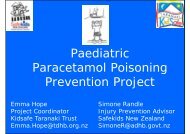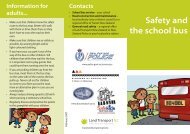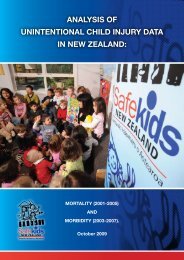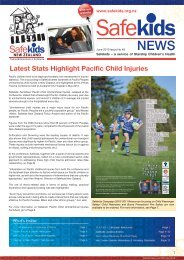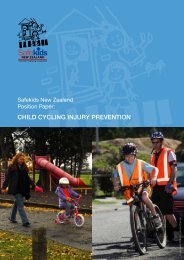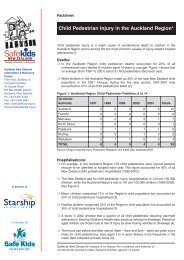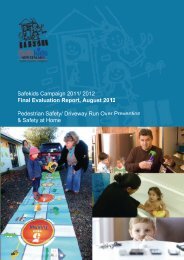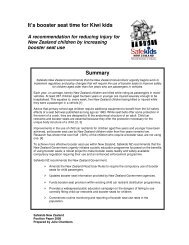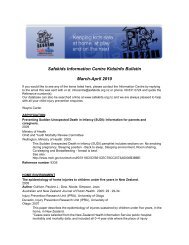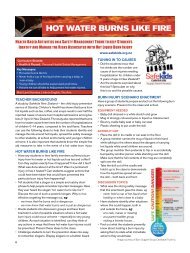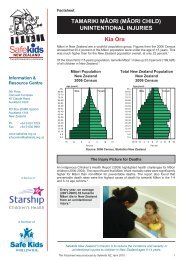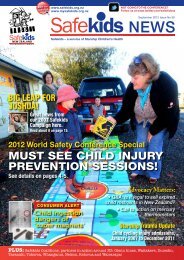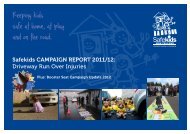Safekids Campaign 2010/11: Fire Safety/ Burns Prevention Contents
Safekids Campaign 2010/11: Fire Safety/ Burns Prevention Contents
Safekids Campaign 2010/11: Fire Safety/ Burns Prevention Contents
Create successful ePaper yourself
Turn your PDF publications into a flip-book with our unique Google optimized e-Paper software.
<strong>Safekids</strong> <strong>Campaign</strong> <strong>2010</strong>/<strong>11</strong>: <strong>Fire</strong> <strong>Safety</strong>/ <strong>Burns</strong><br />
<strong>Prevention</strong><br />
<strong>Burns</strong> <strong>Prevention</strong> Toolkit<br />
Formative Evaluation Report<br />
Prepared by Simone Randle, June <strong>2010</strong><br />
<strong>Contents</strong><br />
<strong>Contents</strong>....................................................................................................................................................1<br />
Executive Summary ..................................................................................................................................3<br />
Introduction ...............................................................................................................................................4<br />
Loving Our Children: Safer Homes: <strong>Burns</strong> <strong>Prevention</strong> Toolkit ..................................................................4<br />
Evaluation Purpose...................................................................................................................................4<br />
Formative Evaluation Methodology...........................................................................................................5<br />
Information and evidence base ............................................................................................................5<br />
Search of resources .............................................................................................................................6<br />
Collaboration with national partners .....................................................................................................6<br />
Pre-testing............................................................................................................................................7<br />
Feedback on the flipchart ................................................................................................................7<br />
Feedback on the Hot Cup magnet...................................................................................................9<br />
Conclusion ................................................................................................................................................9<br />
Recommendations ..................................................................................................................................10<br />
Appendix 1: SWIP <strong>Burns</strong> and Scalds education resource development 2008/9 .....................................<strong>11</strong><br />
Appendix 2: Feedback Form...................................................................................................................14<br />
Appendix 3: Success Definition Table.....................................................................................................16<br />
Appendix 4: Hot Cup Magnet Designs ....................................................................................................17
Executive Summary<br />
This evaluation report has been produced by <strong>Safekids</strong> New Zealand for <strong>Campaign</strong> Key Agencies,<br />
Coalitions and sponsors including: Safe Waitakere Injury <strong>Prevention</strong> (SWIP) - Waitakere City Council,<br />
National <strong>Burns</strong> Centre, New Zealand <strong>Fire</strong> Service, Burn Support Group Charitable Trust Inc. and the<br />
Ministry of Health (MoH).<br />
<strong>Safekids</strong> New Zealand produced the Loving Our Children: Safer Homes: <strong>Burns</strong> <strong>Prevention</strong> Toolkit in<br />
support of the <strong>Safekids</strong> <strong>Campaign</strong> <strong>2010</strong>/<strong>11</strong>: <strong>Fire</strong> <strong>Safety</strong>/ <strong>Burns</strong> <strong>Prevention</strong>. The Toolkit, first<br />
developed by SWIP was reproduced by <strong>Safekids</strong> with support from <strong>Campaign</strong> sponsors and partners.<br />
<strong>Safekids</strong> acknowledges and thanks SWIP and all sponsors and partners for their support.<br />
This evaluation report extends from the <strong>Safekids</strong> <strong>Campaign</strong> <strong>2010</strong>/<strong>11</strong> Evaluation Plan; which identified<br />
the development of resources as a priority evaluation area. The purpose of the evaluation was to<br />
determine the usefulness and value of the Toolkit to providers working with whanau/ families.<br />
This report details formative evaluation methods utilised to produce the Loving Our Children: Safer<br />
Homes: <strong>Burns</strong> <strong>Prevention</strong> Toolkit. Evaluation methods adhere to the National Guideline for Health<br />
Education Resource Development in New Zealand, Ministry of Health, 2002.<br />
Evaluative activities undertaken include:<br />
<br />
<br />
<br />
<br />
Formation of an evidence base to profile child burn injuries and identify key prevention<br />
messages;<br />
National and international search to identify existing burns prevention resources;<br />
Consultation with national partners to ensure the Loving Our Children: Safer Homes: <strong>Burns</strong><br />
<strong>Prevention</strong> Toolkit enhanced existing information and resources which promote the prevention<br />
of childhood burns;<br />
Pre-testing of a draft Toolkit with providers able to deliver burns prevention messaging to<br />
parents of children from birth to five years.<br />
Feedback from pre-testing participants provided strong support for the Toolkit; safety messages were<br />
universally considered relevant, clear and appropriate to a wide range of cultures and settings.<br />
Feedback participants praised the simple, visual design concept and practicality of the Toolkit.<br />
Changes and improvements recommended by feedback participants related to minor features and not to<br />
key messaging or the design concept.<br />
Participants requested that the resource be produced in a range of languages; this recommendation is<br />
subject to the availability of funding.<br />
<strong>Safekids</strong> extends gratitude to all feedback participants who volunteered valuable time to the<br />
development of this resource.<br />
3
Introduction<br />
<strong>Safekids</strong> New Zealand has developed a public awareness/ education toolkit in support of the <strong>Safekids</strong><br />
<strong>Campaign</strong> theme: <strong>Burns</strong> <strong>Prevention</strong>/ <strong>Fire</strong> <strong>Safety</strong>. The Loving Our Children: Safer Homes: <strong>Burns</strong><br />
<strong>Prevention</strong> Toolkit has been designed to support the delivery of burns prevention/ fire safety information<br />
to families/ whanau with children under five years of age. This report details the results, conclusions and<br />
recommendations of formative evaluation activities undertaken as part of the resource development<br />
process.<br />
Formative evaluation and pre-testing activities identified in the <strong>Safekids</strong> <strong>Campaign</strong> <strong>2010</strong>/<strong>11</strong> Evaluation<br />
Plan were utilised through the resource development process. Consultation with <strong>Campaign</strong> and<br />
evaluation stakeholders was undertaken to develop the Evaluation Plan. Copies are obtainable from<br />
<strong>Safekids</strong> on request.<br />
Evaluation activities detailed in the Plan are consistent with the National Guideline for Health Education<br />
Resource Development in New Zealand, Ministry of Health (MoH), 2002.<br />
Loving Our Children: Safer Homes: <strong>Burns</strong> <strong>Prevention</strong><br />
Toolkit<br />
The Loving Our Children: Safer Homes: <strong>Burns</strong> <strong>Prevention</strong> Toolkit includes:<br />
‣ 1 X Flipchart booklet<br />
‣ 50 X Hot Cup magnets (originally designed as an all-purpose, reusable sticker)<br />
‣ 1 X Practitioners’ Guide<br />
The flipchart was first developed by SWIP. <strong>Safekids</strong> extends thanks and acknowledgement to all<br />
members of the coalition who originally produced the resource.<br />
A national burns Key Agency Group (KAG) reproduced the original resource in support of the <strong>Safekids</strong><br />
<strong>Campaign</strong>. Members of the burns KAG include SWIP, National <strong>Burns</strong> Centre, New Zealand <strong>Fire</strong><br />
Service, Burn Support Group Charitable Trust Inc. and <strong>Safekids</strong> New Zealand. <strong>Safekids</strong> extends thanks<br />
to members of the KAG for their support of the <strong>Safekids</strong> <strong>Campaign</strong>.<br />
Evaluation Purpose<br />
The <strong>Safekids</strong> <strong>Campaign</strong> Evaluation Plan <strong>2010</strong>/<strong>11</strong> identified formative evaluation of <strong>Campaign</strong> resources<br />
as a priority evaluation area. The purpose of evaluative activity was to ensure the resource development<br />
process incorporated measures to check the usefulness and benefit of the final resource.<br />
4
The value of the Loving Our Children: Safer Homes: <strong>Burns</strong> <strong>Prevention</strong> Toolkit lies in the assumption that<br />
the resource will be acceptable to a wide range of practitioners from the injury prevention and health<br />
promotion sectors, home visitors, educators and anyone with the capacity to deliver fire safety and<br />
burns prevention information to families/ whanau.<br />
An ineffective resource is unlikely to inspire use by providers and the public may not receive the safety<br />
information.<br />
Formative Evaluation Methodology<br />
Local and regional child health and safety experts participated in a consultation process facilitated by<br />
SWIP during the development of the original resource. Feedback strongly supported the Toolkit’s<br />
modular design which provides burn prevention information in alignment with ages and developmental<br />
stages of children from birth to 5 years. Care was taken to ensure that issues and messaging within<br />
each module were relevant to parents of children within the targeted age groups.<br />
A process development report prepared by SWIP was accepted by the Ministry of Health (see Appendix<br />
1). Formative evaluative activities conducted by <strong>Safekids</strong> have built on SWIP’s original work. Activities<br />
undertaken by <strong>Safekids</strong> include: the development of an information and evidence base, a national and<br />
international search of burns prevention resources, collaboration with <strong>Campaign</strong> partners and resource<br />
pre-testing.<br />
Information and evidence base<br />
The development of the resource was evidence based. <strong>Safekids</strong> built a profile of childhood burn injuries<br />
through the review and analysis of:<br />
<br />
<br />
<br />
<br />
<br />
National fatality data<br />
National hospital admission data<br />
National and international research<br />
National fire safety and burns services<br />
ACC claims data<br />
A <strong>Safekids</strong> Factsheet was produced from synthesised information. The factsheet: Child Burn Injuries<br />
underwent a peer review process with Key Agency partners.<br />
The factsheet identified that childhood burn injuries occur in a variety of ways:<br />
Fatalities: On average, more than five children die from a burn injury each year. Causes of child burn<br />
fatalities include: exposure to fire and flame, electric current and to a hot object/ substance.<br />
5
House fires in which children die are most commonly caused by unattended heaters or someone playing<br />
with matches/ lighters or candles.<br />
Hospitalisation: On average, five to six children are hospitalised each week as a result of a burn injury.<br />
The main cause of burn related admission is contact with heat and hot substances.<br />
Common causes of heat/ hot substance burns include spilt hot drinks (tea and coffee) and other liquids<br />
(soups/ noodles) and hot tap water in baths/ showers/ sinks.<br />
High risk groups: Groups most frequently injured from a burn include:<br />
‣ Children under five years<br />
‣ Boys<br />
‣ Children living with higher levels of socio-economic deprivation<br />
‣ Children living in urban areas<br />
‣ Maori and Pacific children<br />
Using this information the Loving Our Children: Safer Homes: <strong>Burns</strong> <strong>Prevention</strong> Toolkit was redeveloped<br />
by <strong>Safekids</strong> to promote fire safety/ burns prevention messages and to encourage best practice safety<br />
measures in the home.<br />
Search of resources<br />
<strong>Safekids</strong> conducted a search of national fire safety/ burns prevention resources, past and present. The<br />
search also included an international internet search which involved making contact with Safe Kids<br />
Worldwide and its nineteen member countries.<br />
Discussions with partner agencies revealed the existence of the SWIP Safer Homes: Loving Our<br />
Children flipchart.<br />
Collaboration with national partners<br />
<strong>Safekids</strong> collaborated with Key Agency partners to ascertain what fire safety/ burns prevention<br />
resources were currently in use in New Zealand. Discussions were also held around what sort of<br />
resource would be of most use to those working to promote child safety with New Zealand families.<br />
The creation of the burns KAG, discussed earlier, was a result of this consultation process. The burns<br />
KAG provided a forum for exchange of expert information and peer review in support of the Loving Our<br />
Children: Safer Homes: <strong>Burns</strong> <strong>Prevention</strong> Toolkit development process.<br />
Consultation the with wider national <strong>Safekids</strong> <strong>Campaign</strong> Key Agency Group indicated support for the<br />
Toolkit.<br />
6
Pre-testing<br />
Initial discussions with SWIP revealed that the pre-testing process for the original resource had focused<br />
on Well Child Providers and Maori providers. <strong>Safekids</strong>’ work expanded on this process by extending<br />
consultation beyond Well Child providers and by collecting feedback from Pacific People’s providers.<br />
Pre-testing of the draft Toolkit aimed to explore:<br />
1. How the information and design concept was received by providers;<br />
2. How the resource could be improved.<br />
Feedback was collected from 25 participants engaged in the following service areas: maternity services;<br />
B4 School Checks; community health, health care and promotion, education, Well Child, Plunket and<br />
Pacific Peoples health services. Feedback participants were based in Auckland City, Wellington and<br />
Christchurch.<br />
Participants were asked to provide feedback on the draft flipchart and a draft set of design concepts for<br />
the magnet. Each participant then completed a self-completion feedback form (see Appendix 2).<br />
<strong>Safekids</strong> extends thanks and acknowledgement to all those who volunteered time to provide comment.<br />
Feedback on the flipchart<br />
Feedback results were collated and analysed against a success definition rating system (see Appendix<br />
3) developed as part of the <strong>Safekids</strong> <strong>Campaign</strong> <strong>2010</strong>/<strong>11</strong> Evaluation Plan:<br />
Clarity of information: 84 percent of participants indicated that the messaging was extremely clear and<br />
12 percent said it was clear. One respondent was unsure.<br />
Utility of flipchart: Of 22 participants who responded to a question on the utility of the flipchart, 59<br />
percent said that they thought the flipchart would be extremely useful for promoting awareness and<br />
understanding of the prevention of childhood burn injuries. 36 percent indicated the flipchart would be<br />
useful. None of the respondents considered the flipchart not to be useful; three participants did not<br />
answer.<br />
What respondents liked about the flipchart: All participants commented on aspects of the flipchart<br />
that they liked. Features of the flipchart that were most frequently mentioned include:<br />
Visuals and images: Participants expressed strong support and appreciation for the visual nature of the<br />
resource and use of colour. Images were considered appropriate for use with a range of cultures and<br />
with families who had English as a second language. Comments also related to the relevance of the<br />
images in terms of every day occurrences within homes.<br />
7
Information and messaging: Participants indicated that messages on the flipchart were clear and easy<br />
to understand. The prompts were considered useful to those delivering burns prevention information.<br />
Comments also related to the easy link between the messaging and visuals.<br />
User-friendly design: Participants were supportive of the simple design and user-friendliness of the<br />
resource.<br />
Ages and stages modules: Participants indicated support for the modular design concept of the<br />
flipchart which linked burns prevention information to ages and stages of development.<br />
Size and portability: Participants commented on the handy size of the flipchart and that it would easily<br />
fit into resource bags.<br />
Participants also liked that the flipchart would help them in their work, was interactive and could be<br />
easily adapted for use in a variety of settings (such as early childhood education centres and Pacific<br />
People's communities).<br />
Improvements to the flipchart: Participants offered suggestions of ways the flipchart could be<br />
improved. Recommendations related to minor changes rather than to key messaging or the design<br />
concept. Seventeen of 25 participants made the following suggestions for improvement:<br />
‣ Last module: a change from ‘5 years’ to ‘4 to 5 years’ was recommended to fit with health<br />
checks before the 5th birthday (such as the B4 School check).<br />
‣ Participants recommended the following changes to wording and messaging:<br />
o Kettle - change to electric jug;<br />
o Inclusion of a warning against using ovens to heat homes;<br />
o Use of '1' and '2' instead of 'first' and 'second';<br />
o Dislike of the word 'severe' (facts page);<br />
o Stronger wording of message around alcohol and cooking.<br />
‣ Participants recommended that the flipchart be made available in other languages.<br />
‣ Participants suggested that the flipchart include something targeted at children.<br />
Other comments related to the use of colour, use of 3D images such as a pop-up book, a<br />
recommendation for more safety information in the generic pages and one suggestion for less<br />
messaging per page.<br />
Respondents also commented on the adaptability of the flipchart for use in a variety of setting such as<br />
educational settings (parent seminars, early childhood centres and schools).<br />
8
Feedback on the Hot Cup magnet<br />
Participants were asked to vote for the magnet designs they liked the most from a range of <strong>11</strong> bilingual<br />
and single language designs (see Appendix 4). Of a total of 46 votes, 24 percent favoured magnet<br />
design ‘A’ which featured a simple design and only one language (English).<br />
On the whole the magnets were received well by participants; there was support for the messaging,<br />
colour schemes and cup shape and participants were keen to see magnets made widely available<br />
and used in a variety of ways (e.g. in preschools and schools, as placemats and coasters). One<br />
comment also indicated support for the magnet being made available as something to leave with<br />
whanau.<br />
A number of participants expressed the need for the Hot Cup magnet to be made available in a range<br />
of languages including Pacific People's languages but also languages of new migrant and refugee<br />
communities, such as Farsi and Arabic.<br />
The bilingual magnets were felt to be too busy and wordy and that the messaging did not stand out.<br />
In general participants felt there should be only one language per magnet. If a bilingual magnet was<br />
produced it was recommended that it be simplistic and clear in its design.<br />
Conclusion<br />
Analysis of feedback results against the Success Definition Table (Appendix 3) gave the Toolkit a ‘very<br />
good’ to ‘excellent’ rating:<br />
‣ <strong>Safety</strong> messages were considered relevant, clear and presented in a visual format appropriate<br />
for a wide range of families, cultures and settings.<br />
‣ Participants felt that the Toolkit would make a worthwhile and valuable contribution to their<br />
work with families.<br />
‣ The Toolkit was found to be user-friendly and of a practical size.<br />
‣ There was strong support for the Hot Cup magnet as a giveaway to leave with families/<br />
whanau.<br />
‣ Recommended for changes/ improvements to the Toolkit related to minor adjustments and not<br />
to key messages or design concepts.<br />
9
Recommendations<br />
Based on feedback collected from participants, this report makes the following recommendations:<br />
‣ Make changes as per participant recommendations in relation to ‘4 to 5 years’ and alter<br />
wording/ messaging where possible;<br />
‣ Make pages of the flipchart available on the <strong>Safekids</strong> website for practitioners and members of<br />
the public to download as colouring sheets for children. These can also be given to parents<br />
as a take-away reminder of information provided;<br />
‣ Make flipchart available on the <strong>Safekids</strong> website as a presentation for discussion in parent<br />
education seminars;<br />
‣ Make flipchart available on <strong>Safekids</strong> website formatted to A3 to enable Coalitions to produce<br />
large flipcharts for use in group settings such as early childhood centres;<br />
‣ Make alterations to the Hot Cup magnet to retain bilingual messaging but simplify and<br />
reduce wording (see cover page for revised design). Bilingual resources are preferable to<br />
single language resources for the following reasons:<br />
1. More economic to produce a bilingual resource than to produce a resource in two<br />
languages;<br />
2. In general, bilingual resources are acceptable to Te Kohanga Reo, Marae, Kura, whanau<br />
and Maori communities. Bilingual resources are seen to be promoting child safety<br />
messages and the Maori language.<br />
<strong>Safekids</strong> recommends that the Loving Our Children: Safer Homes: <strong>Burns</strong> <strong>Prevention</strong> Toolkit be adjusted<br />
to accommodate the above changes and made available for dissemination through <strong>Campaign</strong> networks.<br />
<strong>Safekids</strong> suggests that the Flipchart and magnet be translated into a variety of languages should<br />
additional funding be made available.<br />
10
Appendix 1: SWIP <strong>Burns</strong> and Scalds education resource development 2008/9<br />
MoH Guidelines (Education Resource<br />
Development)<br />
Determine the need for a health education<br />
resource or range of resources.<br />
Determine the type of resource that needs to be<br />
developed to meet the identified needs.<br />
Develop a distribution and marketing plan.<br />
Determine if a suitable or similar resource<br />
already exists.<br />
Consider adapting an existing resource.<br />
<strong>Burns</strong> and Scalds cause severe injuries to young children often requiring a long rehabilitation<br />
process which impacts on the child and their family for many years. There have been a range<br />
of resources developed over many years, one of which was a parent education kit. This<br />
resource had been a valuable tool for group education opportunities. At the <strong>Safekids</strong> planning<br />
day in May 2008, there was much interest from community organisations and stakeholders to<br />
update this original <strong>Burns</strong> and Scalds education kit developed by Safe Waitakere.<br />
It was recognised that the methodology for educating care-givers in the past is not particularly<br />
relevant today. The most common format for adult education around child injuries is to create<br />
kits which can be delivered to groups of care-givers and which cover all aspects of the issue.<br />
In Waitakere, the community agencies and workforce felt that a more targeted approach<br />
would better suit both the contracts they are working under and the busy lifestyles of today’s<br />
families. It was also noted that group education opportunities have diminished and one on<br />
one education is preferred by both care-givers and community workers.<br />
Distribution of the new resources would initially be through the member organisations of the<br />
Waitakere child safety coalition, many of whom are involved in home visiting programmes<br />
which include a safety component.<br />
No similar resource exists currently. There are group education packages available through<br />
Child <strong>Safety</strong> Foundation and <strong>Burns</strong> Charitable Trust but no home visitor education resource.<br />
The coalition group decided to utilise the earlier Safe Waitakere group education kit,<br />
maintaining the simple illustration format.<br />
<strong>11</strong>
Check consistency of the draft content with<br />
existing national and local policies.<br />
Get technical accuracy checked.<br />
Check for educational appropriateness.<br />
Check for cultural appropriateness (depending<br />
on audience).<br />
Check for relevant consideration of the<br />
advertising standards codes.<br />
Check for regional appropriateness.<br />
Consider concept testing the artwork concepts<br />
and the main themes of the resource on a focus<br />
The development of this resource aligns with goal 9 of the NZ Health Strategy. Under the<br />
NZIP Strategy the objectives 5 and 7 deal with the integration of injury prevention through<br />
collaboration and implementation of effective interventions. The development of this resource<br />
fits into both these objectives and into the first of the outcomes for 2008-<strong>11</strong> – addressing<br />
serious injuries.<br />
Next came the process of reviewing both the content of the original resource and all available<br />
information from leading agencies such as NZ <strong>Fire</strong> Service, SafeKids, Child <strong>Safety</strong><br />
Foundation etc. A number of messages were adjusted, deleted or incorporated accordingly.<br />
It is important to note that we looked for consistency and alignment of messaging to reduce<br />
confusion and ensure support for the project.<br />
In the one area where there was a technical component, the coalition group suggested it<br />
would be simpler for delivery if we used an alternative. Also there was no consistency<br />
internationally for this component. Therefore alternative advice is given rather than a specific<br />
hot water temperature.<br />
All representatives from local home visiting programmes were comfortable with the<br />
development of the key messages and how they fit into their specific education programmes.<br />
Utilising a primarily pictorial method for delivery and ensuring that resources left with families<br />
have little or no written components was welcomed by local providers. It was acknowledged<br />
that this format would not be appropriate for our Pacific project due to the nature and make-up<br />
of Pacific families. However the illustrations and information will be utilised in a Pacific<br />
resource in 2009 to support burns & scalds education for Pacific families.<br />
N/A<br />
The resource was made available through the regional Injury <strong>Prevention</strong> network for comment<br />
from their perspective. Many of the regional IP coordinators attended the subsequent training<br />
days.<br />
Throughout the entire development process all key stakeholders were consulted on the style<br />
and content of the artwork. A number of changes were made through this process e.g. baby<br />
12
group composed of the priority audience.<br />
Check for appropriate content and design<br />
characteristics.<br />
Pre-test the draft version of the resource on<br />
focus group/s composed of the priority<br />
audience.<br />
Include publication details and the resource<br />
code on the resource, if it is intended to be<br />
included in the national catalogue for<br />
distribution.<br />
Include linkage details with related resources.<br />
Send a preproduction copy of the resource to<br />
your contract manager in the Ministry of<br />
Health for approval.<br />
Manage production.<br />
Deposit three copies of the resource with the<br />
National Resource Provider.<br />
Deposit three copies of the resource with the<br />
National Library.<br />
Commence distribution and marketing.<br />
in cot changed from side sleeping to back sleeping and smoke alarm picture refined. All<br />
agencies were comfortable with the non-specific ethnicity of the people in the illustrations.<br />
As above and we also worked on the layout and the appropriateness of the content for<br />
specific age groups.<br />
A draft version of the resource was taken to all stakeholders and through them to the<br />
audience. Further suggestions on layout and design were made.<br />
N/A<br />
N/A<br />
Included in 6 monthly reports to MoH.<br />
Production was very simple and completed in a short timeframe.<br />
N/A<br />
N/A<br />
All resources were delivered to the providers along with staff training on delivery of the<br />
messages. Both staff and management appreciated this time to discuss and fully understand<br />
the key messages to ensure consistent delivery across the Waitakere area.<br />
Undertake the level of evaluation appropriate<br />
to the resource.<br />
Write a report on the development, production<br />
and distribution of the resource.<br />
13
Appendix 2: Feedback Form<br />
<strong>Safekids</strong> <strong>Campaign</strong> <strong>2010</strong>/<strong>11</strong>: <strong>Burns</strong> <strong>Prevention</strong><br />
Provider Self-Completion Feedback Form<br />
‣ Safer Homes: Practitioners burns and scalds education flipchart<br />
‣ Hot Cup: multipurpose coaster/ magnet<br />
1. What organization or sector of the workforce do you represent (eg Well Child, home visitor<br />
heath promoter)?<br />
2. Please rate the clarity of information and messaging included in the flipchart. Please tick<br />
one box.<br />
Excellent Good Unsure Somewhat clear Unclear<br />
3. As a provider, how useful do you think the flipchart is for promoting awareness and<br />
understanding of the prevention of childhood burns? Please tick one box.<br />
Extremely useful Useful Unsure Somewhat useful Not at all<br />
useful<br />
4. What did you like about the flipchart?<br />
5. How could the flipchart be improved?<br />
6. Please share any other information about the usefulness of the flipchart.<br />
14
7. Please indicate which hot cup sticker designs you like the most. Please circle as many<br />
letters as required<br />
A B C D E F<br />
G H I J K<br />
8. Is there anything else you would like to comment on with regard to the stickers?<br />
Thank you<br />
15
Appendix 3: Success Definition Table<br />
Rating<br />
Explanation<br />
Excellent<br />
All information and messaging promoted by the resource is aligned to<br />
information promoted by other safety and injury prevention agencies. 75% or<br />
more of recipients of the resource (parents, caregivers, and teachers)<br />
understood key information and messaging. 75 % or more of injury<br />
prevention coordinators considered the resource to be practical and useful;<br />
little change was recommended. The resource was well received by<br />
coordinators and recipients.<br />
Very good<br />
All information and messaging promoted by the resource is aligned to<br />
information promoted by other safety and injury prevention agencies. 60% or<br />
more of recipients of the resource (parents, caregivers, and teachers)<br />
understood key information and messaging. 60 % or more of injury<br />
prevention coordinators considered the resource to be practical and useful;<br />
some change was recommended. The resource was well received by<br />
coordinators and recipients.<br />
Good<br />
All information and messaging promoted by the resource is aligned to<br />
information promoted by other safety and injury prevention agencies. 50% or<br />
more of recipients of the resource (parents, caregivers, and teachers)<br />
understood key information and messaging. 50% or more of injury prevention<br />
coordinators considered the resource to be practical and useful; a number of<br />
changes were recommended. The resource was well received by instructors<br />
and recipients.<br />
Poor<br />
The information and messaging on the resource is not aligned to information<br />
promoted by other safety and injury prevention agencies. Recipients of the<br />
resource (parents, caregivers, and teachers) were confused by the<br />
messaging. Injury prevention coordinators questioned the usefulness of the<br />
resource and recommended an overhaul of the design concept. Coordinators<br />
reported that they would not be inclined to use the resource and recipients<br />
indicated that they did not like the resource.<br />
16
Appendix 4: Hot Cup Magnet Designs<br />
A<br />
B<br />
C<br />
D E F<br />
G H I<br />
J<br />
K<br />
17



